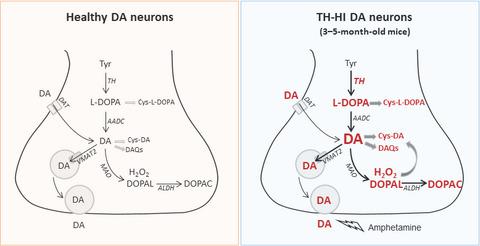当前位置:
X-MOL 学术
›
J. Neurochem.
›
论文详情
Our official English website, www.x-mol.net, welcomes your
feedback! (Note: you will need to create a separate account there.)
Too much for your own good: Excessive dopamine damages neurons and contributes to Parkinson's disease
Journal of Neurochemistry ( IF 4.2 ) Pub Date : 2021-06-28 , DOI: 10.1111/jnc.15442 Anna Masato 1 , Luigi Bubacco 1 , Elisa Greggio 1
Journal of Neurochemistry ( IF 4.2 ) Pub Date : 2021-06-28 , DOI: 10.1111/jnc.15442 Anna Masato 1 , Luigi Bubacco 1 , Elisa Greggio 1
Affiliation

|
Dopamine dyshomeostasis is a driving factor of nigrostriatal degeneration in Parkinson's disease (PD). Accumulation of cytosolic dopamine at striatal projections results in the buildup of autoxidation products, which generates protein adducts and exacerbate oxidative stress. Moreover, an excessive rate of dopamine degradation results in accumulation of 3,4-dihydroxyphenylacetaldehyde (DOPAL), a toxic metabolite which rapidly reacts with other proteins. These events lead to protein misfolding and cross-linking as well as mitochondrial and lysosomal dysfunction, the main pathological mechanisms underscoring dopaminergic neuron loss in PD. In this issue of Journal of Neurochemistry, Vecchio et al. generated and characterized a new in vivo model of chronic dopamine accumulation through the overexpression of a hyperactive form of tyrosine hydroxylase (TH-HI), the rate-limiting step enzyme in dopamine biosynthesis. At 3–5 months of age, TH-HI mice displayed increased striatal dopamine content, exacerbated dopamine catabolism, and augmented responses to amphetamine. This correlated with enhanced oxidative stress and DOPAL buildup, highlighting a catechol-induced neurotoxic vicious cycle that may anticipate a parkinsonian-like phenotype in aged mice. This novel TH-HI animal model represents an exciting new tool to unravel the molecular mechanisms underlying dopamine disequilibrium, catecholamine autotoxicity, and neurodegeneration in PD.
中文翻译:

对你自己的好处太多了:过多的多巴胺会损害神经元并导致帕金森病
多巴胺失调是帕金森病 (PD) 黑质纹状体变性的驱动因素。纹状体投射处胞质多巴胺的积累导致自氧化产物的积累,从而产生蛋白质加合物并加剧氧化应激。此外,多巴胺降解速度过快会导致 3,4-二羟基苯乙醛 (DOPAL) 的积累,这是一种与其他蛋白质快速反应的有毒代谢物。这些事件导致蛋白质错误折叠和交联以及线粒体和溶酶体功能障碍,这是 PD 中多巴胺能神经元丢失的主要病理机制。在本期神经化学杂志上, Vecchio 等人。通过过度表达酪氨酸羟化酶(TH-HI)(多巴胺生物合成中的限速步骤酶)的过度表达,产生并表征了一种新的慢性多巴胺体内积累模型。在 3-5 个月大时,TH-HI 小鼠纹状体多巴胺含量增加,多巴胺分解代谢加剧,对苯丙胺的反应增强。这与增强的氧化应激和 DOPAL 积累相关,突出了儿茶酚诱导的神经毒性恶性循环,这可能预示着老年小鼠的帕金森样表型。这种新颖的 TH-HI 动物模型代表了一种令人兴奋的新工具,可以解开 PD 中多巴胺不平衡、儿茶酚胺自身毒性和神经变性的分子机制。
更新日期:2021-08-19
中文翻译:

对你自己的好处太多了:过多的多巴胺会损害神经元并导致帕金森病
多巴胺失调是帕金森病 (PD) 黑质纹状体变性的驱动因素。纹状体投射处胞质多巴胺的积累导致自氧化产物的积累,从而产生蛋白质加合物并加剧氧化应激。此外,多巴胺降解速度过快会导致 3,4-二羟基苯乙醛 (DOPAL) 的积累,这是一种与其他蛋白质快速反应的有毒代谢物。这些事件导致蛋白质错误折叠和交联以及线粒体和溶酶体功能障碍,这是 PD 中多巴胺能神经元丢失的主要病理机制。在本期神经化学杂志上, Vecchio 等人。通过过度表达酪氨酸羟化酶(TH-HI)(多巴胺生物合成中的限速步骤酶)的过度表达,产生并表征了一种新的慢性多巴胺体内积累模型。在 3-5 个月大时,TH-HI 小鼠纹状体多巴胺含量增加,多巴胺分解代谢加剧,对苯丙胺的反应增强。这与增强的氧化应激和 DOPAL 积累相关,突出了儿茶酚诱导的神经毒性恶性循环,这可能预示着老年小鼠的帕金森样表型。这种新颖的 TH-HI 动物模型代表了一种令人兴奋的新工具,可以解开 PD 中多巴胺不平衡、儿茶酚胺自身毒性和神经变性的分子机制。











































 京公网安备 11010802027423号
京公网安备 11010802027423号